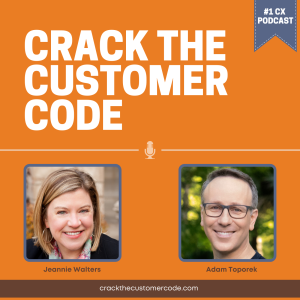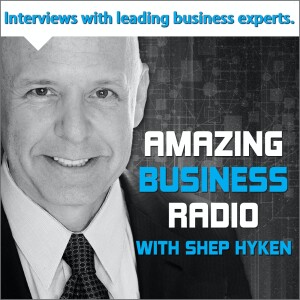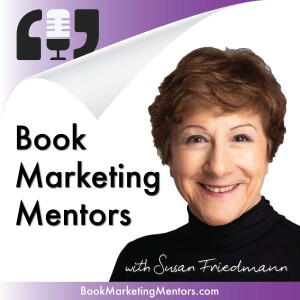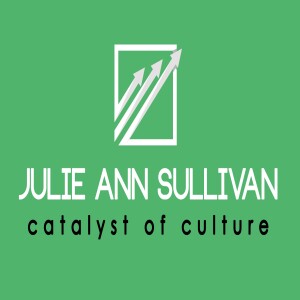

Episode List

Betty-Ann Heggie: Understanding Gender Dynamics
How do we change the culture of business to value both masculine and feminine attributes? How do we learn to recognize the unconscious bias that fuels inequality? Betty-Ann Heggie contends that mentorship and open dialogue are key first steps in understanding gender dynamics in the workplace and overcoming our subconscious conditioning.Heggie is a speaker, author and mentor in the realm of gender physics, the study of masculine and feminine energy present in each of us. A widely recognized thought leader, Heggie’s work on gender dynamics has been featured in Harvard Business Review, Inc. Magazine and Huffington Post, and she has been inducted into the Hall of Fame of Canada’s Top 100 Most Powerful Women. Heggie is committed to helping men and women make progress together in the modern workplace, and she is the author of Gender Physics: Unlock the Energy You Never Knew You Had to Get the Results You Want. Today, Heggie describes the subconscious bias that informs our expectations of how men and women should act and explains how it makes impacts who we see as leaders in the workplace. She offers insight around making the conscious effort to overcome such conditioning, suggesting conversation and calling out inequality as the first steps in creating change. Listen in for Heggie’s advice on building relationships with potential mentors, both male and female, and learn how to look at mentorship as being open for growth. Key Interview Takeaways Subconscious bias informs our expectations around how men and women should act. We tend to associate the skills of leadership with masculine traits like independence and self-sufficiency, and female leaders have to cloak those characteristics in feminine skills to be liked and accepted.Initiating the conversation is the first step in changing the culture of business. Women need both male and female mentors to navigate the workplace, and when men fail to treat their female colleagues as equals, we need to call them out on it. We must make a conscious effort to overcome conditioning and take baby steps forward together.Build relationships with potential mentors before you ask for their time. Professional women are particularly busy, so start by inviting them to coffee. Let them know that you admire their achievements and value their opinions—and see where it goes. Mentorship means being open for growth. If you are struggling to find the right mentor, look to other resources. President Lincoln, for example, leveraged reading to learn about military leadership during the Civil War. Consider formal programs in which prospective mentors have already volunteered their time. Explore your local Chamber of Commerce and online communities like Lean In for established mentorship programs. Heggie also suggests reaching out to people you admire on social platforms like LinkedIn. Connect with Betty-Ann Heggie Betty-Ann Heggie’s WebsiteBetty-Ann Heggie on FacebookBetty-Ann Heggie on Twitter Resources Gender Physics: Unlock the Energy You Never Knew You Had to Get the Results You Want by Betty-Ann Heggie“Analysis of Human Brain Structure Reveals that the Brain ‘Types’ Typical of Males Are Also Typical of Females, and Vice Versa” in Frontiers in Human NeuroscienceLean InLean In: Women, Work, and the Will to Lead by Sheryl Sandberg Learn more about your ad choices. Visit megaphone.fm/adchoices

Kristine Lilly & Dr. Lynette Gillis: Olympic Gold Medalist Soccer Player Shares Key to Teamwork
We know that exceptional team members contribute to the success of a team. And yet, it takes more than a group of superstars to win a championship. How do you get people to put the team first? How do you create chemistry among players? How do you build a winning team that plays for each other, either on the field or in the workplace?Kristine Lilly served as a midfielder on the US Women’s Soccer Team through five FIFA World Cups and three Olympic games. A member of both the US Olympic Hall of Fame and US Soccer Hall of Fame, Lilly is an expert on effective teamwork. Dr. Lynette Gillis specializes in corporate strategy and organizational behavior, serving Concordia University in the roles of professor, Dean of the College of Business and Associate Provost. Lilly and Dr. Gillis are also the coauthors of Powerhouse Teams: 13 Teamwork Tactics that Build Excellence and Unrivaled Success. Today, Lilly and Dr. Gillis discuss how the characteristics of powerhouse teams translate from the playing field to the workplace. Lilly shares some of the factors that made the 1999 US Women’s National Soccer Team successful, explaining how they built a winning mentality and put their egos aside for the betterment of the group as a whole. Listen in for insight around how leaders can unite a team with a big vision and learn how the opportunity to advance the game of soccer for women and girls inspired Lilly’s team to win big! Key Interview Takeaways Powerhouse teams share the same characteristics, regardless of setting. The 1999 Women’s National Soccer Team provides a model for excellence in teamwork that translates to any organization; the players exhibited trust, friendship, reliance on each other and a sense of resilience.A strong leader unites their team with a big vision. Lilly credits Coach Anson Dorrance with teaching the team to play for each other and inspiring them to go beyond winning to ‘sell the game of soccer.’For a team to excel, team members must put their egos aside. Lilly’s team was successful because the players accepted each other’s differences and bought into the idea that it’s not about the individual, it’s about the team. Team chemistry is created by a center set. Teams that work well together are united by a common draw. For Lilly’s team, the players all bought into the mission of advancing the game of soccer for women and girls—and winning! Powerhouse teams build a winning mentality. Lilly and her teammates worked with a mental skills coach on imagery and intention, developing practices that helped players focus on what they needed to do on the field. Connect with Kristine Lilly & Dr. Lynette Gillis Kristine Lilly’s WebsiteKristine Lilly on TwitterKristine Lilly on LinkedInLeadershipXDr. Lynette Gillis on TwitterDr. Lynette Gillis on LinkedIn Resources Powerhouse: 13 Teamwork Tactics that Build Excellence and Unrivaled Success by Kristine Lilly and Dr. John Gillis Jr. with Dr. Lynette GillisAnson DorranceTony DiCiccoDr. Colleen HackerLearn more about your ad choices. Visit megaphone.fm/adchoices

Dr. Barbara Cox: Building Connection in Corporate Culture
Corporate culture is creating an epidemic of loneliness. As humans, we are wired for community, yet most workplaces disregard this need for connection and leave us feeling isolated. How can we, as individuals and organizations, build social bonds and foster collaboration? How can we establish a balance between masculine and feminine energy to promote a sense of belonging AND improve the bottom line?Dr. Barbara Cox is a psychologist, coach and author who explores the power of the feminine archetype to build community, cultivate intuition and create lasting, positive change in organizations. Her work has appeared on NBC News, Euro News and MSN, among many other national media outlets, and Dr. Cox was a featured speaker at UNESCO’s 2018 World Congress for the Organization of World Heritage Cities. She is also the author of The Muse Process: Unleashing the Power of the Feminine for Success and Fulfillment.Today, Dr. Cox explains how our bodies are wired to be in community, encouraging us to build in time each day to connect with friends and colleagues. She offers insight around developing an awareness of the times you DO feel like you fit in and finding one or two people you resonate with in any given situation. Listen in for Dr. Cox’s advice on tuning in to the wealth of information your body can provide and learn how to activate your own inner success muse! Key Interview Takeaways Our bodies are wired to be in community. Humans have evolved to live and work in groups, and when we feel disconnected, we don’t perform as well—and that impacts the bottom line.Build in time to connect with friends and colleagues. Dr. Cox argues that if you’re feeling isolated, others are too, and she encourages individuals and organizations to devote at least five minutes each day to social activity.Be aware of when you DO feel like you fit in. Dr. Cox encourages us to bring attention to the moments when we feel connected and cultivate those relationships. In one case, a client improved her sales numbers 106% by leveraging this advice. Activate your inner success muse. Get in touch with your holistic, right brain to foster creativity and access your subconscious mind. Give yourself the validation to fit in anywhere. Dr. Cox believes that you can feel a sense of belonging in any situation once you realize that fitting in is a state of mind and commit to finding at least one or two people you resonate with. Get in tune with your mind-body system. Most of us operate from the neck up, dismissing the intelligence of our bodies. Dr. Cox contends that if you listen to the signals, your body will tell you who to connect with and who to avoid. Connect with Dr. Barbara Cox Dr. Cox’s WebsiteThe Muse Process on Facebook Resources The Muse Process: Unleashing the Power of the Feminine for Success and Fulfillment by Dr. Barbara Cox Learn more about your ad choices. Visit megaphone.fm/adchoices

Claire Akin: Creating a Memorable Personal Brand
What is the secret to creating a successful personal brand? How do you make yourself memorable? Why do you need to share your WHY? What role does content marketing play in helping you connect with potential clients?Claire Akin is the founder of Indigo Marketing, a firm dedicated to helping financial advisors and third-party administrators grow their business. Prior to starting her own venture, Akin served as an Investment Advisor at Thomas J. Dobransky & Associates, and she earned her BA in economics from UC Davis and her MBA in marketing at UC San Diego. Akin is also the author of the popular book, The LinkedIn Guide for Financial Advisors: Six Steps to Identify Qualified Prospects and Generate Referrals.Today, Akin explains how she made the decision to start her own firm, describing how she created offerings around client needs. She also offers insight into running a business, discussing the importance of focusing on metrics that drive success and outsourcing everything you can. Listen in for Akin’s advice on creating a memorable personal brand and learn how she balances career and family through strong routines and accountability partners.Key Interview TakeawaysThe riches are in the niches. Akin’s side project, the Fiddle Leaf Fig Plant Resource Center, has eclipsed her primary business in terms of revenue by establishing her as the go-to expert in that specialty.Focus on the metrics that drive success. Looking at her numbers (site visitors, webinar registrations, sales calls, etc.) on a weekly basis keeps Akin honest about the performance of her business.Outsource everything you can. Build a talented team and delegate anything that is not a good use of your time.Create memorable branding and tell your personal story. Make it easy for people to remember you and explain why you are passionate about what you do.The secret to content marketing is consistency. Akin’s weekly blog posts keep her top-of-mind with financial advisors and drive her business. She contends that you should give away 90% of what you know about a subject in the spirit of helping people.To balance career and family, develop strong routines. Akin builds time into her day to get specific things done, and she outsources accountability to experts such as a business coach and personal trainer.Connect with Claire AkinIndigo Marketing AgencyIndigo Marketing on FacebookClaire on LinkedInClaire on TwitterFiddle Leaf Fig Plant Resource CenterResourcesThe Fiddle Leaf Fig Expert: Your Guide to Growing Healthy Ficus Lyrata Plants by Claire AkinStart with Why: How Great Leaders Inspire Everyone to Take Action by Simon SinekThe LinkedIn Guide for Financial Advisors by Claire AkinThe 2016 LinkedIn Guide for Financial Advisors by Claire AkinLearn more about your ad choices. Visit megaphone.fm/adchoices

Tevis Trower: Moving Beyond Buzzwords to Transform Culture
Tevis Trower is the founder and CEO of Balance Integration, a consulting firm dedicated to humanizing the work experience. Trower is a pioneer in the realm of cultural transformation, leveraging her expertise in mindfulness, leadership development and employee engagement to create an environment where people feel valued and in turn, develop a commitment to the organization’s goals. Balance Integration boasts a client list that includes heavy-hitters like Disney and Morgan Stanley, and Trower’s work has been featured in Forbes, Fortune and Business Week, among many other media outlets.Today, Trower explains why we cannot change work culture with policy statements, describing how leaders must move beyond proclamations around bringing the whole self to work and truly embody the authenticity they value. She also explores the idea of employee engagement, discussing the mistake leaders make in driving performance rather than engagement and outsourcing it as a problem to solve rather than a behavior to model. Listen in for Trower’s insight on the significance of leadership alignment and learn how you can foster a new sense of possibility in an organization at large.Key Interview TakeawaysWe cannot change work culture with policy statements. To truly shift the environment in an organization, we must go beyond proclamations and take our powerful mission and values statements to heart.Code switching implies a fear of being authentic at work. Trower points out that bringing our whole selves to work serves as an elixir, while the fear of being ourselves creates an environment where we must conform in order to feel safe.Leaders must role model authenticity in the workplace. If there’s a satisfaction gap in what you get out of work, then there is a contribution gap in what you’re bringing to work, and Trower suggests that the authenticity in organizations begins with the leaders’ willingness to show up as ‘more human.’Engagement is not a problem to solve. Corporate leadership tends to focus on driving performance, while they outsource engagement to someone else in the organization. Trower argues that to engage employees, leaders need to see engagement as a behavior to model.Leadership alignment enables cultural empowerment. When the C-suite works to close the gap between what they want to create and what they are manifesting now, such a shift creates a new sense of possibility in the organization at large.Connect with Tevis TrowerBalance IntegrationBalance Integration on LinkedInBalance Integration on InstagramBalance Integration on FacebookTevis on TwitterResourcesC-Suite SessionsLearn more about your ad choices. Visit megaphone.fm/adchoices
Create Your Podcast In Minutes
- Full-featured podcast site
- Unlimited storage and bandwidth
- Comprehensive podcast stats
- Distribute to Apple Podcasts, Spotify, and more
- Make money with your podcast







